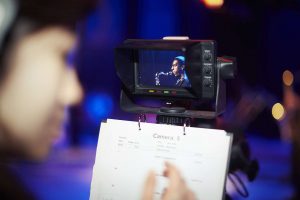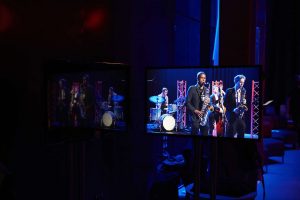This blog post was originally published by the AHRC.
After The Fast Show, how does one present jazz on television? This was a question that I kept asking myself in the months leading up to the studio shoot of Jazz 1080, a practice-as-research output of my AHRC ECR Research Leadership project Jazz on BBC-TV 1960-1969. By taking a programme from idea to realisation, I hoped to better understand the everyday practice of music television production. Where previously I had written about the work of BBC professionals through recourse to the Written Archive Centre at Caversham, now I was taking my research onto the studio floor. As much as I wanted my finished programme to be successful, it was the process that led up to its production which taught me the most.
Suddenly technical specifications, studio floorplans, risk assessments and Programme-as-Broadcast documents were not archival artefacts to be decoded; they were now practical requirements and crucial elements of the organisational momentum. Imitating the two-day schedule of a 1960s programme such as Jazz 625 (BBC2, 1964-1966), we would spend Day 1 rigging the studio and reserve Day 2 for camera rehearsal and recording. We would shoot as live, vision mix as live, in front of a live studio audience.
As a researcher, I was observing crew dynamics and the consequences of creative decisions. As a TV producer, I was assembling a crew, sourcing equipment, co-ordinating freelancer contracts and working with the band on their repertoire. This was my first engagement with a practice-as-research methodology, in which I allowed my reactive relationship to unfolding events shape my intellectual approach. It was undoubtedly the most terrifying, and rewarding, experience of my professional life.
Perhaps the most instructive aspect was understanding the timescales of production. At Caversham, I had consulted camera scripts for jazz programming, often appended with hasty scribbles. When it came to our shoot, I finally understood the circumstances of those scribbles. While the leader of our featured band, Birmingham saxophonist Xhosa Cole, had been working on song arrangements for months beforehand, it was only two hours before we recorded that a definitive running order was established. During our camera rehearsal, director and vision mixer Mark Kershaw had worked with Jayne Savage, script supervisor, to plot camera movement and shots. But the nature of jazz is such that the music changed between rehearsal and shoot – I learned that a great deal of improvisation happens in the production gallery as well as on the studio floor.
The chemistry of a studio crew, and their ability to communicate, is essential to successful television production. We assembled a core team of ex-BBC Pebble Mill professionals in the roles of director, vision mixer, script supervisor, sound supervisor, lighting director and camera supervisor. The remainder of our crew – camera operators, camera assistants, sound technicians, autocue operators – were made up of Birmingham City University students. One concern throughout the production process was that these relatively inexperienced students would struggle with the intense discipline of a multi-camera shoot. We were immensely fortunate that our core crew had instructed at the BBC training academy at Wood Norton and so had the patience and skill to guide our student participants.
Indeed, for me, the most enjoyable aspect of the shoot was seeing our students leap into the unknown with such enthusiasm and energy. We asked a lot of them and they delivered with great professionalism. Our finished programme is a testament to their potential, as well as being a record of an exciting moment in the Birmingham jazz scene, personified by The Xhosa Cole Quintet.
Making a 50-minute jazz show has given me a unique insight into the creativity and pragmatism involved in television production. Too often, the programmes created by visionary producers like Terry Henebery for the BBC during the 1960s are seen to be mere documents of jazz performance. But they are also exemplary documents of the BBC’s working practices, the institution’s interaction with a vital music scene and its ability to reflect the social and cultural significance of jazz for British audiences. Historical re-enactment as a methodology has enlivened the television production process for me, allowing me to understand the artistic and operational decisions which make cameras move and allow microphones to record. The Fast Show’s Jazz Club sketches are still funny because they engage with these processes too; they are another example of historical recreation.
***
Dr Nicolas Pillai is co-lead of the Jazz Studies research cluster, based in the School of Media at Birmingham City University. He is the author of Jazz as Visual Language: Film, Television and the Dissonant Image (2016, I. B. Tauris) and co-editor of New Jazz Conceptions: History, Theory, Practice (2017, Routledge).







